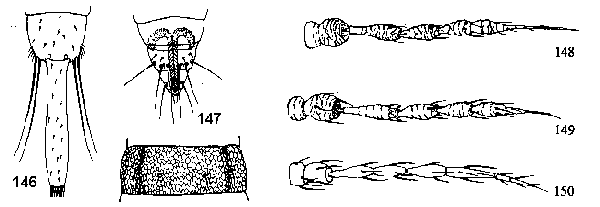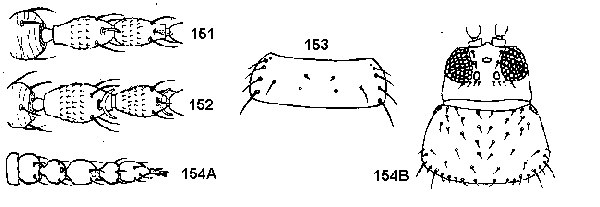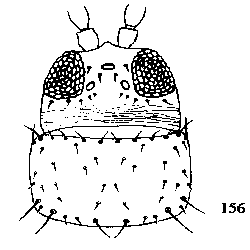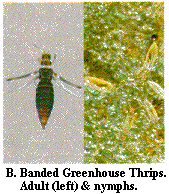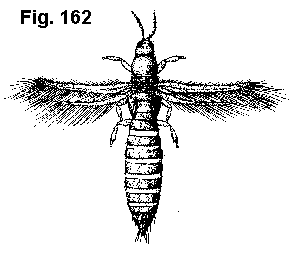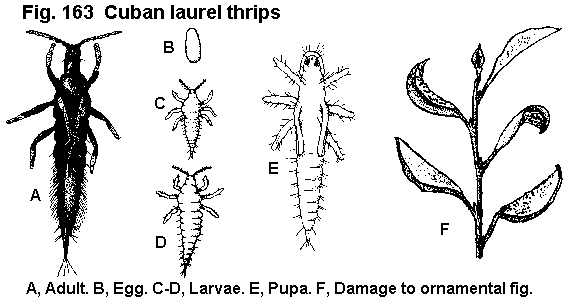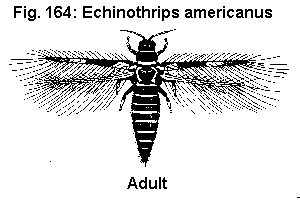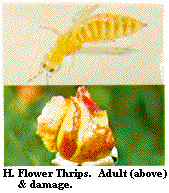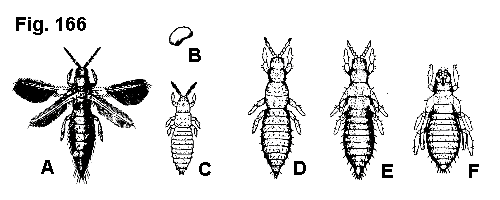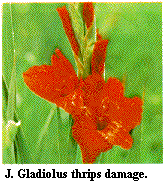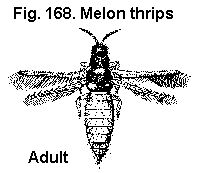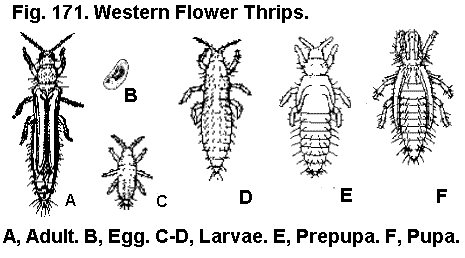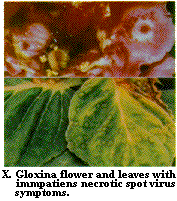Introduction
Thrips are relatively small, 0.5 to 5 mm long (most are 1 to 2 mm). Wings may be present or absent; and the wings when present are unique among insects because they are narrow, with few or no veins, fringed with long hairs that hence give the order's name, THYSANOPTERA. Mouthparts are piercing-sucking with only a left mandible. Antennae are short (four to nine segments). The tarsi have one or two segments with one or two claws and are bladderlike at the end. They can reproduce sexually or asexually, and females are the most common sex found. Thrips are divided into two suborders, Terebrantia and Tubulifera, that differ in the shape of the last abdominal segment and the development of the ovipositor. The Terebrantia have the last abdominal segment more or less conical or rounded, and the female almost always has a well-developed, sawlike ovipositor. The Tubulifera have the last abdominal segment tubular, and the females lack an ovipositor. The families of thrips are separated largely by the characters of the antennae, particularly the number of antennal segments and the nature of the sensoria on the third and fourth segments. A total of 11 species belonging to two families of two suborders (Phlaeothripidae-Tubulifera, Thripidae-Terebrantia) are included here.
The metamorphosis of thrips is somewhat intermediate between simple and complete. The first two instars are called larvae. In the suborder Terebrantia, these are followed by the third and fourth instars which are inactive, do not feed, and have external wing pads. The third instar is called a prepupa and the fourth the pupa, and are often spent on the ground in soil or litter. In the suborder Tubulifera, the third and fourth instars are prepupae and the fifth pupa. The two sexes of thrips are similar in appearance, but the females are usually larger in size and lighter in color. The thrips with an ovipositor usually lay their eggs in plant tissue; those without an ovipositor lay their eggs in crevices or under bark. Thrips run, crawl, and jump and can move rapidly. Flight is the major method of active dispersal; however, they can be aerially dispersed by drifting in wind currents for many miles.
A great number of thrips are plant feeders. Both larvae and adults feed on flowers, leaves, twigs, or buds, using their piercing-sucking mouthparts, causing structural abnormalities of foliage in the form of leaf malformation (distorted, dwarfed, and matted), leaf fold, leaf roll, leaf blisters, and sometimes defoliation; causing discoloration of petals, deformation, or scarring of flowers. A few species feed on fungus spores, a few species are predaceous on other small arthropods (mites, thrips, and aphids) and a few species may bite man. A very important aspect of thrips is the transmission of virus diseases. Tomato spotted wilt virus, is transmitted by the western flower thrips, tobacco thrips, and onion thrips.
Key to Eleven Species of Thrips Found on Flowers and Foliage
- Last abdominal segment (X) tubelike; female without sawlike ovipositor; body blackish brown, antennae yellow except for light brown terminal segment; on Ficus (Phlaeothripidae) - CUBAN LAUREL THRIPS
Last abdominal segment (X) rarely tubelike (Figure 146); female always with sawlike ovipositor (Thripidae) - GO TO 2 -
Body strongly sclerotized, sculptured or reticulated (Figure 147); antennal segments III and IV usually strongly vasiform and/or antennal style (segments VII to VIII) extremely long (Figure 148, Figure 149), at least two-thirds as long as VI - GO TO 3
Body usually with transverse sculpture; antennal style shorter - GO TO 4
-
Forewings with fringe cilia straight; median dorsal abdominal setae closely set; sense cones on antennal segments III and IV simple (Figure 148); legs entirely pale yellow - GREENHOUSE THRIPS
Forewings with fringe cilia predominately wavy (Figure 155); median dorsal setae placed fairly far apart; sense cones on antennal segments III and IV forked (Figure 149, Figure 152); legs yellow except mid and hind femora, which are brown - BANDED GREENHOUSE THRIPS
Forewings with fringe cilia wavy (Figure 155); median dorsal setae closely set; sense cones on antennal segments III and IV simple (Figure 150, Figure 151); head and pronotum with wrinkles inside reticulations; legs brown with base of femora, apical one third to half of tibiae and all tarsi yellow - ECHINOTHRIPS AMERICANUS -
Antennae each seven segmented (Figure 154A) - GO TO 5
Antennae each eight segmented - GO TO 6
-
Abdomen uniformly pale yellow, body without any brown makings; posterior margins of abdominal tergites II to VII without conical teeth; abdominal tergite II with four lateral setae (Figure 153) - MELON THRIPS
Abdomen uniformly brown; posterior margins of abdominal tergites II to VII with conical teeth; abdominal tergite II with 0 to 3 lateral setae; head narrow, prothorax as in Figure 154B - COMPOSITE THRIPS
-
Pronotum with well developed anteromarginal, anteroangular setae, and 2 pairs of posteroangular setae; head with 3 pairs of ocellar setae (Figure 155); coloration of antennae, body and forewings various; abdominal sternites lack accessory setae (Frankliniella spp.) - GO TO 7
Pronotum with only 2 pairs of well developed posteroangular setae; head with 2 pairs of ocellar setae (Figure 156); antennae brown except III yellow, body brown, forewings brown, abdominal sternites II to VII with accessory setae - GLADIOLUS THRIPS -
Macropterous; abdomen either pale yellow with brown patches on the meson, or entirely dark brown - GO TO 8
Brachypterous; color generally dark brown to lighter brown especially the thorax and head - TOBACCO THRIPS (in part)
-
Pedicel of antennal segment III straight without thickened middle ring (Figure 157A, Figure 158A); comb on posterior margin of abdominal tergite VIII complete or incomplete (Figure 157B, Figure 158B) - GO TO 9
Pedicel of antennal segment III with a distinctly thickened middle ring which in profile appears as angulations (Figure 159A, Figure 160A); setal comb on posterior margin of abdominal tergite VIII incomplete - GO TO 10
-
Comb on posterior margin of abdominal tergite VIII complete (Figure 157B); anteromarginal and anteroangular setae on pronotum of similar length; postocular setae longer, as stout as the interocellar setae (Figure 157C); color various - WESTERN FLOWER THRIPS
Setal comb on posterior margin of abdominal tergite VIII incomplete (Figure 158B); anteroangular setae usually longer then anteromarginal setae on pronotum; postocular setae shorter and more slender than the interocellar pair; predominately brown (Figure 158C) - TOBACCO THRIPS
-
Pedicel of antennal III segment with distal and basal parts equally diverging; pair of dorsal setae on antennal segment II not enlarged nor on projections (Figure 159A); head and abdominal tergite VIII as in Figure 159B, Figure 159C - FLOWER THRIPS
Pedicel of antennal segment III strongly angulated, 12 to 14 m wide with profile of apex and base diverging strongly; pair of dorsal setae on antennal segment II enlarged, on projections (Figure 154A); head and abdominal tergite VIII as in Figure 160B, Figure 160C - FLORIDA FLOWER THRIPS
Banded Greenhouse Thrips
Banded greenhouse thrips (Figure 161), Hercinothrips femoralis (O.M. Reuter), Thripidae, THYSANOPTERA
DESCRIPTION
Adult
Female banded greenhouse thrips, approximately 1.5 mm long, are primarily yellow at first but gradually darken to brown or black. The eyes are red; the narrow, fringed wings are gray brown with 3 white crossbands (Figure B). Males are rare.
Egg
When first deposited, the translucent elongate eggs are white 0.25 mm in length. Before hatching, each eggs wells and becomes dull white.
Larva
The yellow or white larvae vary from 0.48 to 1.5 mm in length. They are wingless and have red eyes.
Pupa and Prepupa
These stages are white and found on the leaves. There are usually more individuals on the lower surface.
BIOLOGY
Distribution
Although sporadically distributed through out North America, banded greenhouse thrips are widely distributed throughout the world. They are particularly common in the British Isles, Europe, and East Africa.
Host Plants
In the greenhouse, banded greenhouse thrips attack many crops including cucumbers, begonias, cacti, date palm, bananas, callas, cestrum, amaryllis, aralia, chrysanthemum, dracaena, rubber tree, gardenia, croton, hydrangea, moon flower, schefflera, screw pine, tomato, and Mexican tea. In one experiment in Georgia, 44 species of plants were used as host plants out of 50 presented. The banded green house thrips showed definite preference for some species among those accepted as host plants.
Damage
Banded greenhouse thrips pierce plant tissues with their mouthparts and suck the juices. As a result, irregular white spots form on the leaf giving it an overall silver appearance. Eventually, these areas dry out and turn light brown. Some defoliation results.
Life History
The banded greenhouse thrips, sometimes referred to as the sugar beet thrips, has gained notoriety as a major floricultural pest. In North Carolina, this thrips was first reported as a greenhouse pest in 1943 on white callas. In the greenhouse, thrips may breed continuously and have several generations per year. Eggs are deposited on the underside of leaves or along the stem. Approximately 2 weeks later, larvae emerge and begin feeding. Colonies of young larvae congregate on the underside of leaves and individuals are often covered with a watery globule of excrement. As the larvae feed, they develop through four instars, molting between each stage. The more mature larvae are typically found along leaf midribs or among dried-up foliage. After a larval stage of approximately 18 days, banded greenhouse thrips pupate. Adult thrips that emerge shortly thereafter are less voracious feeders than the larvae. Adults live 40 or more days and females may reproduce with or without mating. Males of this species are rarely found.
CONTROL
Banded greenhouse thrips are vulnerable to contact insecticides. Stored bulbs can be dusted with such an insecticide to prevent a thrips infestation on plants the following season. For specific insecticides and rates, consult the current Cooperative Extension publications on ornamental plant pests.
Composite Thrips
Composite thrips (Figure 162), Microcephalothrips abdominalis (D.L. Crawford), Thripidae, THYDANOPTERA
DESCRIPTION
Adult
Females of this species are yellowish brown to dark brown, and the head is small with black eyes and red ocelli. Intermediate antennal segment, apex of fore femora, and all tarsi lighter, becoming yellow brown to yellow. The forewings are brownish gray. Prothorax longer than wide and moderately covered with setae. Males are smaller and paler than females. Males have a dark brown head and pale yellow body.
Eggs
The eggs are yellowish and small, almost spherical (with a slightly narrow anterior end). Eggs average 0.12 mm long and 0.08 mm in diameter.
Larva
The first instar is translucent to whitish yellow and is 0.36 to 0.68 mm long. The second instar is yellow with the head smaller in relation to thorax and abdomen. Body length is 0.68 to 1.0 mm.
Pupa and Prepupa
The prepupa is sluggish and moves only when disturbed. It is pinkish yellow and 0.71 to 1.0 mm long. It rests in the outer bracts of the flower or between the lower ends of florets. The pupa is inactive, robust, and pinkish yellow. Male pupae are 0.63 to 0.81 mm and female pupae are 0.89 to 1.4 mm long.
BIOLOGY
Distribution
The composite thrips is a new world thrips found throughout most of North America. It is an occasional inhabitant of greenhouses throughout the southeastern United States.
Host Plants
Adults and larvae usually are found in the flowers and are rarely found on the foliage. Composite thrips occurs in great abundance on flowers of chrysanthemum, cosmos, zinnia, and marigold.
Damage
Heavy infestations cause damage to the corolla, stamens, and developing seed of plants in the Compositae. Petals lose pigmentation, senesce early, and drop prematurely.
Life History
The life cycle requires 11 to 13 days at 27°C. Eggs hatch in 72 to 80 hours. The first and second instars last about 3 days each, the prepupal stage requires 24 hours or less, and the pupal stage varies from 24 to 48 hours. Eggs are laid inside the tissue of the disc floret. Females are 15 times more numerous than males. Reproduction is both sexual and parthenogenetic. New females begin to lay eggs 72 to 96 hours after emergence from the pupal stage.
CONTROL
For specific insecticides recommendations, consult current Cooperative Extension publications on ornamental plant pests for your state.
Cuban Laurel Thrips
Cuban laurel thrips (Figure 163), Gynaikothrips ficorum (Marchal), Phlaeothripidae, THYSANOPTERA
DESCRIPTION
Adult
Cuban laurel thrips are large thrips (2.6 to 3.6 mm) that are dark yellowish brown to black.
Egg
The eggs is cylindrical with rounded ends, smooth, and translucent white.
Larvae
The first stage larva is a tiny, translucent white insect. In top view the first stage larva is almost oval. Second stage larvae are also translucent white but are similar to the adult in size and shape. Both instars have red eyes. The abdominal segments taper from the thorax. In top view the second stage larvae are shaped like an elongate diamond. The posterior tube becomes dark in older larvae and is held pointing up.
Prepupa and Pupa
Prepupae are similar to second stage larvae except that the wing buds are externally visible. Pupae have longer wing buds and the antennae are folded back over the head.
BIOLOGY
Distribution
The Cuban laurel thrips is a pantropical species that occurs wherever Ficus retusa is planted. It has been recorded outdoors in California, Texas, Hawaii, and Florida.
Host Plant
Cuban laurel thrips feed on Indian laurel, weeping fig, India rubber plant, other figs, and various shrubs and herbs. In the floricultural industry, weeping fig is the host most often infested.
Damage
This pest feeds on the tender, pale green leaves causing sunken, reddish to purplish spots along the midrib. Immature thrips cause the leaves to curl inward or fold into a pocket in which the thrips continue to develop and in which they lay eggs. Heavily infested leaves eventually become tough and brown or yellow. They eventually drop from the plant prematurely. Infested trees will not be killed, but the ornamental value of the plant is reduced markedly. Like the flower thrips, the Cuban laurel thrips also bites people.
Life History
Eggs are laid in great numbers inside the surface of the curled leaf. All stages of development can be found at any time within the pocket galls. Development from egg to egg-laying females takes about 30 days. Adult Cuban laurel thrips are active fliers and migrate rapidly during hot weather.
CONTROL
Because the Cuban laurel thrips only attacks the tender, new foliage on small plants, it should be possible to prune out the new growth and eliminate the thrips population. Consequently there is no suitable foliage for feeding and oviposition and the infestation should die out before new growth emerges.
Two anthocorid bugs, Macrotracheliella laevis Champion and Cardiastethus rugicollis Champion have been reported to be predators of the Cuban laurel thrips in Puerto Rico. Another anthocorid bug, Montandoniola moraguesi (Puton), was introduced from the Philippines in Hawaii to control this thrips. The insidious flower bug is a common predator of the Cuban laurel thrips in Florida. For specific insecticides and rates, consult the current Cooperative Extension publications on ornamental plant pests.
Echinothrips Americanus
Echinothrips americanus (Figure 164), Echinothrips americanus Morgan, Thripidae, THYSANOPTERA
DESCRIPTION
Adult
The adult female Echinothrips americanus is about 1.6 mm long and the male about 1.3 mm long. The general body color is dark brown with red between the abdominal segments. Segments 1 and 2 of the antenna are dark brown, 3 and 4 lighter. Forewings are pale gray at base, middle, and tip with light brown in between.
Egg
Laid in plant tissue, elongate and clear to white.
Larva
Immediately after hatch the larvae are clear but they change to white and then become light or pale yellow after feeding. The second-stage larvae become cream colored before molting to prepupae.
Pupa and Prepupa
Both are found on leaf tissue and move only when disturbed. Prepupa is white with short wing pads and antennae extend forward. Pupa is white with long wing pads and the antennae bend back over body.
BIOLOGY
Distribution
Echinothrips americanus has a range over most of the eastern United States. It has been reported as a pest of nursery and landscape plants in the southern part of its range and as a greenhouse pest on several plants.
Host Plant
This thrips will feed on both the upper and lower leaf surfaces but is usually more common on the lower surface. They have been found and reproduce on most ornamental plants tested and many of the common weed species of Georgia. In an experiment in Georgia, out of 51 species of cultivated plants and 75 native plants studied, feeding and reproduction was observed on 40 cultivated and 59 native species. Of all the greenhouse host plants; poinsettias, Irish shamrock, and impatiens are the most common hosts in Georgia. They also have been common on chrysanthemum foliage and flowers. They also have been a pest on woody ornamentals.
Damage
This thrips feeds on leaf tissue and the damage is very similar to typical mite damage with light spots on the leaf. Their numerous but shallow punctures result in injured tissue with a shrunken appearance, and the light color is a result of the cell constituents, including chlorophyll, being removed. Infested leaves will have numerous black specs on them that are fecal drippings of the thrips. They also will feed on parts of the flower.
Life History
Female E. americanus deposits eggs separately in slits in the leaf tissue. Eggs were deposited at random on the leaf surface. Developmental time depended on temperature, at 15°C the egg stage averaged 15.5 days and the immatures took 18.4 days for a total of 33.9 days. Under warmer conditions development was faster, at 30°C the egg stage took 5.8 days and the immatures only 5.6 days for a total of 11.4 days from egg to adult. Developmental time varied with different host species. All stages were present throughout the year in the greenhouse. Adults and immatures were not very active and would remain in the same area of a leaf for days if not disturbed.
CONTROL
Different populations of this thrips have expressed different susceptibility to insecticides. Greenhouse populations in Georgia have been susceptible to most insecticides. There have been reports of populations on woody nursery plants that were difficult to control. For specific insecticides and rates, consult current Cooperative Extension publications on ornamental plant pests.
Flower Thrips
Flower thrips (Figure 165), Frankliniella tritici (Fitch), Thripidae, THYSANOPTERA
Florida flower thrips (common name not approved by ESA), Frankliniella bispinosa Morgan, Thripidae, THYSANOPTERA
DESCRIPTION
Adult
The flower thrips and the Florida flower thrips are exceedingly similar. They can be separated only by microscopic examination. Both are approximately 1 mm to 1.25 mm long and yellow, with brown blotching, especially about the middle of the thorax and abdomen (Figure H). Males are smaller than females and are lighter in color.
Egg
The flower thrips delicate egg is cylindrical, and slightly kidney-shaped, with a smooth pale or yellow surface.
Larva
The immature thrips is lemon yellow, resembling the adult except for its lack of wings.
BIOLOGY
Distribution
The Florida flower thrips has been found in Florida, Georgia, and Alabama and is likely distributed in other states of the southern United States. Evidently because of their small size, flower thrips are carried over large areas by frontal wind systems, the maximum rate of migration taking place in early week of June. Trapping records by sticky cards showed that these thrips are found in relatively equal numbers up to 135 feet (45 m). They have even been trapped at altitudes of 10,000 feet (3,100 m). The flower thrips has also been reported in Western states. These thrips enter greenhouses through vents or doors, on plants brought into the house, or on people or supplies coming into the house.
Host Plants
Florida flower thrips have been reported from over one hundred species of plants. Roses and citrus are favorite hosts, particularly the white varieties. Most plants of the Rosaceae are infested. Flowers of a more or less open structure, where the stamens and pistils are easily accessible, are favorites. Flowers such as nightshade with stamens in a tube about the pistil are also favorites. Flower thrips have been collected from 29 plant orders including various berries, cotton, chrysanthemums, daisies, day lilies, field crops, forage crops, grass flowers, legumes, peonies, privet, roses, trees, truck crops, vines, and weeds. They seem to prefer grasses and yellow or light-colored blossoms. Roses are most susceptible in June.
Damage
Florida flower thrips always feeds on the most tender part of the plant, such as buds, flowers, or leaves. The effect of their numerous but shallow punctures is to give the injured tissue a shrunken appearance, and the damage is described as piercing and sucking fluids from the cells. The thrips feed on the thick fleshy petals, pistils, and stamens of the flower, and then the affected parts turn brownish-yellow, blacken, shrivel up, and drop prematurely. Infested rose blossoms turn brown, and buds open only partially. The petals, distorted with brown edges, seem to stick together. Only the epidermis and relatively few mesophyll cells are affected. They also may feed on ovary or young fruit on some host plants. The numerous and shallow punctures on the surface cause characteristic markings that lower marketability dramatically.
Life History
No published work has been done on the biology of the Florida flower thrips. The flower thrips was described in 1855 from Wisconsin. During warm periods, swarms of these tiny insects often fly in the afternoon. Flower thrips bite people, causing a noticeable stinging sensation. Their large numbers account for considerable and rapid damage to flowers, especially those with light-colored petals. Yet thrips contribute to pollination of some crops, an unexpected benefit! Flower thrips are generally found at the bases of the petals. They reproduce throughout the year in the warmer parts of the Southeast, with the majority of their 12 to 15 generations occurring in the warmer months. Newly emerged females begin to lay eggs within 1 to 4 days in summer and within 10 to 35 days in winter, reproduction being much faster in warmer weather. In summer, the adult stage is reached in about 11 days. Flower thrips pass through egg, two larval, prepupal, pupal, and adult stages. The eggs are inserted into flower or leaf tissue, and the prepupal and pupal stages are spent in the soil. In summer, flower thrips may live 26 days, though overwintering thrips may live all winter. Flower thrips can overwinter as far north as North Dakota in grass clumps and other sheltered refuges.
CONTROL
Insecticides are currently used by most flower growers for control of flower thrips. As these thrips are not present until the blossoms open, pesticide applications may cause flower burn. For specific insecticides and rates, consult the current Cooperative Extension publications on ornamental plant pests.
Gladiolus Thrips
Gladiolus thrips (Figure 166), Thrips simplex (Morison), Thripidae, THYSANOPTERA
DESCRIPTION
Adult
Gladiolus thrips emerge milky-white, but soon turn dark brown, except for the apical portions of the legs which are lighter. The wings, brown apically and lighter basally, appear to be darker with a grey band when folded over the back. This thrips is about 1.5 to 1.65 mm long. Males are smaller slightly smaller and lighter in color than the females.
Egg
The eggs are opaque, white, kidney-shaped, and about 0.34 mm long and 0.2 mm in diameter.
Larva
The larvae of the gladiolus thrips are light or pale yellow with red eyes and are about 1.0 mm long when fully developed.
Pupa and Prepupa
The pupae move only when disturbed and develop through two instars. The first instar (prepupa) has short wing pads and the antennae project forward. The second instar (pupa) has long wing pads and the antennae are folded back onto the head. Both stages are dark orange with red eyes and about 1.2 mm in length.
BIOLOGY
Distribution
Gladiolus thrips is now found wherever gladioli are grown. However, it cannot overwinter out-of-doors in northern Europe and northern North America.
Host Plants
The gladiolus thrips most seriously damages gladioli, but is also a pest of iris, carnation, lily, narcissus, freesia, amaryllis, tigerflower, poker plant, tomato, begonia, primula, snapdragon, chrysanthemum, and geranium.
Damage
Plants severely infested with gladiolus thrips have a spotted, bleached appearance (Figure J). Both leaves and petals are fed upon and appear withered. If flower buds are seriously damaged, the flowers fail to open. The entire plant may become stunted.
Life History
Gladiolus thrips are believed to be an introduced pest from Africa, where gladioli are native. The thrips are brought into previously uninfested fields or greenhouses on infested corms. These rather sluggish thrips can overwinter at any stage on stored corms or on plants growing in greenhouses. Although the gladiolus thrips can maintain a population outside during the summer, they cannot overwinter outside in areas where the temperature consistently falls below 10°C.
These thrips have six stages in their life cycle: the egg, two larval instars, two pupal instars and the adult stage. Females deposit 100 to 200 eggs. Many times females greatly out-number the males in a population and parthenogenesis occurs. Parthenogenetic females produce eggs that develop into males. Temperature greatly determines the duration of each stage. During the warm growing season the development of the gladiolus thrips can occur in about 2 weeks. With such rapid development, the thrips can have nine or more generations outside during the growing season. The eggs are deposited in the leaves of gladioli or in the corms in storage. Larvae and pupae can be found in the buds or leaf sheaths, although the larvae often drop to the ground to transform into the quiescent pupae. Adult gladiolus thrips live 35 to 40 days.
CONTROL
For specific insecticides and rates, consult the current Cooperative Extension publications on ornamental plant pests.
Greenhouse Thrips
Greenhouse thrips, Heliothrips haemorrhoidalis (Bouche), Thripidae, THYSANOPTERA
DESCRIPTION
Adult
The head and central area of the body have a distinct network of lines. The body is dark brown with the posterior end much lighter; the legs are uniformly yellow; the wings are hyaline and narrow, but with a broad base; and the antennae are slender with a characteristic needle-like tip. The mature adults are about 1.3 to 1.8 mm long. The male is similar to the female thrips, but slightly smaller.
Egg
The eggs are very small, banana-shaped, and white.
Larva
The first larval instar is white; the second instar is yellow. Both instars have red eyes.
Pupa and Prepupa
The pupa and prepupa do not move about freely. These stages are yellowish with red eyes. Pupae are slightly larger, with longer wing pads, and antennae bent back over body. They become darker with age.
BIOLOGY
Distribution
Although the greenhouse thrips is limited to tropical areas outside, it is found throughout the world in greenhouses. This thrips probably originated in Central and South America.
Host Plants
The greenhouse thrips has over 100 hosts, principally greenhouse and ornamental plants, but also a few crops and tropical plants. Some of the hosts are azalea, begonia, croton, cyclamen, ferns, fuchsia, grape vines, orchids, palm, and rose.
Damage
This thrips feeds almost entirely on the foliage, and large populations cause severe damage. Greenhouse thrips usually injure inner leaves and fruit. Damaged leaves appear silvery or bleached and, if the damage is severe enough, turn yellow and drop. Fruit that has been attached is brown, cracked, and has noticeable sunken areas. Dark spots of excrement are often noticeable on the leaves and fruit.
Life History
Each female deposits 25 to 50 eggs in slits in the leaves. Under optimum conditions the time for development is 17 to 20 days for the eggs, about 13 days for the two larval instars, and about 5 days for the prepupal and pupal stages. The adults can live 7 weeks on plants growing in the greenhouse. All stages can be found throughout the year in greenhouses. Greenhouse thrips move relatively slowly and rarely fly. They prefer a cool, shady, and fairly moist atmosphere. These thrips feed in colonies on the foliage and fruit. They select neither the youngest nor the oldest leaves on which to feed. Often the fruit is preferred to the leaves. Since males are not common, reproduction is usually by parthenogenesis (laying unfertilized eggs). Males were first found in 1940.
CONTROL
For specific insecticides and rates, consult the current Cooperative Extension publications on ornamental plant pests.
Melon Thrips
Melon thrips (Figure 168), (common name not approved by ESA), Thrips palmi Karny, Thripidae, THYSANOPTERA
DESCRIPTION
Adult
Melon thrips have a clear yellow body without darker blotches but with thick, blackish body setae. Antennal colors variable. The pronotum has two pairs of major setae and posterior angles and antennal segments 3 and 4 each have a forked sense cone.
Egg
No description available.
Larva
No description available.
Pupa and prepupa
No description available.
BIOLOGY
Distribution
The melon thrips was first established in the United States in Hawaii around 1982. An established field population was first discovered in the continental United States in 1991 in Florida. It has been distributed in South and Southeast Asia, Pacific Islands, and Caribbean Islands.
Host Plants
The melon thrips has an extremely wide range of host plants, including nearly all kinds of vegetables, many fruit trees and weeds, and several flowering plants such as chrysanthemums and carnations. They quickly build up heavy infestations causing severe injuries.
Damage
Immature thrips and adults feed on leaves, (first along midribs and veins), stems (near growing tip), flowers (all parts), and fruits (on the surface). Severe damage results from sucking plant sap leaving silvery scars from empty cells. Heavy feeding results in a silvered or bronzed appearance and will kill the plant.
Life History
The melon thrips eggs are deposited within plant tissues singly. Larvae have two stages, that feed on plant tissues. The second instar larvae, when mature, fall to ground, where they molt to prepupae and pupae in the soil. After emergence, the adults move to the growing parts of the plants such as young leaves, flowers, or young fruits, where they feed and lay eggs. Adults are usually found on young leaves, while larvae are found on lower or older leaves. Few thrips are found on flowers or fruits. At higher temperatures generation times are shorter. The average development times are: 80.2 days at 15°C, 40.7 days at 20° C, 24.8 days at 25°C, and 20.5 days at 30°C. The reproductive rate reaches maximum at 25°C. The adults reproduce sexually and parthenogenetically.
CONTROL
Chemical insecticides have not been consistent in controlling this pest. None cause more than 80 percent mortality. Several predators attack the melon thrips, including predaceous mites in the genera Amblyseius and Phytoseius (Acarina: Phytoseiidae), insidious flower bugs, and several species of predaceous thrips, ants, and rove beetles. For specific insecticides and rates, consult the current Cooperative Extension publications on ornamental plant pests.
Onion Thrips
Onion thrips (Figure 169), Thrips tabaci Lindeman, Thripidae, THYSANOPTERA
DESCRIPTION
Adult
Adult females of onion thrips are about 1.1 to 1.2 mm long, yellow, with brownish blotches on the thorax and the median portion of abdomen. Antennae are gray with the first segment lighter than other segments. Males are rare.
Egg
The eggs are very small, about 0.2 mm long, kidney shaped, and white. They are deposited within plant tissues.
Larva
The first instar larva is white, about 0.35 to 0.38 mm long. The second instar larva is yellowish, about 0.7 to 0.9 mm long.
Pupa and Prepupa
The pupa and prepupa are similar to the second instar larvae in color and shape, except for having small wing pads.
BIOLOGY
Distribution
Onion thrips have been found in most countries throughout the world.
Host Plants
Onion thrips are extremely polyphagous. They inhabit leaves, shoots, and flowers of many plants. It prefers to feed on onions, but feeds on many field crops, vegetables, various flowers, and bedding plants. It may cause heavy damage to chrysanthemums and carnations.
Damage
Generally feeding of onion thrips cause yellowing or dropping of leaves, buds, or flowers. High infestation results in stunted growth, brown blisters, white blotches, silvery whitish areas or feeding scars. Young terminal leaves frequently show malformation when heavily attacked, with crinkly surfaces, sunken and raised thin areas, marginal erosion, margin curling inwardly, and a chlorotic yellowish appearance with grayish color along all large veins. Young buds may be killed as soon as they come out. In addition, they freely feed within flowers, attacking the tender portions.
Life History
Onion thrips have six to ten generations depending on temperature. Adults and larvae overwinter in the soil or plant litter on the ground. Pupae and prepupae overwinter in the soil. The average length of development is: 6 to 8 days for eggs, 10 to 14 days for larvae, 5 to 9 days for prepupae and pupae, and about 20 days for a generation. It may take as long as 35 days for a generation if temperature is at 15°C. The lower developmental threshold is about 11.5°C and using this threshold as a base, development required 191 degree days. Adults reproduce parthenogenetically through out the season, rarely reproduce sexually, and resulting in that most adults in the field are female. The average adult life is around 32 days, and pre-oviposition, oviposition and post-oviposition periods are 6.1, 22.5, and 3.9 days, respectively. The average number of eggs laid by an unmated female is 37.4 (20 to 200).
CONTROL
The application of chemical insecticides is the common control measure. The onion thrips problem in an integrated pest management program can be solved by using selective pesticides or by using selective treatments such as soil drenches. A combination of selective chemical insecticides and a predaceous mite in the genus Amblyseius (Acarina: Phytoseiidae) have been successfully used to control this thrips. For specific insecticides and rates, consult current Cooperative Extension publications on ornamental plant pests.
Tobacco Thrips
Tobacco thrips (Figure 170), Frankliniella fusca (Hinds), Thripidae, THYSANOPTERA
DESCRIPTION
Adult
The female tobacco thrips is dark brown or black, slender, and about 1 mm long. Each 8-segmented antenna has several yellowish middle segments; the rest of the segments are much darker. Males are usually yellow.
Egg
The white egg cannot usually be seen because it is inserted into the plant tissue.
Larvae
Both stages of tobacco thrips larvae are very light yellow.
Prepupa and Pupa
After the larval stages, tobacco thrips develop through two resting stages, the prepupa, and pupa. Each stage is yellowish and sluggish. These stages are spent in a close hiding place, usually on the ground. The antennae are directed toward the front of the insect in the prepupal stage and are held back over the head and thorax in the pupal stage.
BIOLOGY
Distribution
This thrips is found throughout the United States and Canada east of the Rocky Mountains.
Host Plants
Many plants are attacked by the tobacco thrips, especially gladioli, many ornamentals, cotton, and peanuts.
Damage
Plants infested with tobacco thrips have silvery outlines traced around the veins, and if the damage is severe, the leaves become yellow. These thrips also leave small black spots on the underside of the leaves.
Life History
In greenhouses and on field-grown flowers, the tobacco thrips is most often found in the fall. This insect is often mistaken for the much more destructive gladiolus thrips; however, the tobacco thrips adult is larger and the antennae are lighter in color than those of the gladiolus thrips.
As is common for many thrips, the tobacco thrips can reproduce parthenogenetically, but males are usually present. Eggs are inserted completely into the leaves. In 6 days the eggs hatch into active young. Two larval stages, a prepupal and a pupal stage, occur within two weeks. An entire life cycle can be completed in about 18 days. Adult thrips live 3 to 5 weeks, and each female deposits about 55 eggs during this time. The adults will have either long or short wings. The longwinged forms usually appear in late spring outside and migrate to a new host. Outside, the tobacco thrips overwinter as shortwinged adults in sheltered areas. Excessively rainy conditions reduce the thrips population. Usually the tobacco thrips are not found grouped together in folded leaves or under the bracts of the flower spikes as are gladiolus thrips.
CONTROL
For specific insecticides and rates, consult current Cooperative Extension publications on ornamental plant pests.
Western Flower Thrips
Western flower thrips (Figure 171), Frankliniella occidentalis (Pergande), Thripidae, THYSANOPTERA
DESCRIPTION
Adult
Western flower thrips are about 1 mm long, with the female larger than the male. The female varies from yellow to dark brown, and has a more rounded abdomen. The male is always pale yellow and has a narrower abdomen (Figure W).
Egg
Yellowish eggs cannot be seen because they are laid into the plant tissue.
Larva
The larvae develop through two instars and are distinctly yellow. Second instars become whitish prior to molting.
Prepupa and Pupa
Both prepupa and pupa are yellowish, quiescent non-feeding stages. The antennae and wing pads are typical for most thrips species.
BIOLOGY
Distribution
The distribution was thought to be limited to west of the Mississippi River prior to 1980. However, this thrips has become the most prevalent species attacking greenhouse flowers throughout the United States and Canada, and many countries in Europe and Asia.
Host Plants
This thrips feeds on almost any flowering plant. Carnations, chrysanthemums, gerberas, geraniums, marigolds, pansies, and roses are the major host plants.
Damage
The western flower thrips feeds on the flowers and foliage by inserting its modified left mandible into the tissue, and sucking the fluids from cells. Oviposition and feeding scars reduce the aesthetic quality and marketability of ornamental plants. When thrips feed on developing tissues, affected cells are unable to expand, and mature leaves and petals are distorted. When thrips feed on expanded tissue, effected cells become filled with air, which imparts a silvery appearance. This thrips also is an important vector of tomato spotted wilt virus and impatiens necrotic spot virus (Figure X).
Life History
Females lay eggs in tender plant tissue. The eggs hatch in 2 to 14 days, depending on temperature. First instar larvae begin feeding on egg eclosion. Second-instar larvae also feed on plant tissue, usually in flowers. These larvae are found in the protection of perianth of the flower or within developing terminal foliage. Late in the second instar they stop feeding and move down the plant to pupate. Thrips develop through two quiescent, non-feeding pupal stages in the soil, plant litter or in a protected area on the plant. Adults emerge and resume feeding on flowers, buds, and terminal foliage. The entire life cycle from oviposition to adult emergence can take 12 days in hot weather to 44 days in cool weather.
CONTROL
The thrips are difficult to manage with pesticides because of their thigmotactic behavior causes them to feed deep in the flowers and buds where they are sheltered from chemicals. Chemical management of western flower thrips has received much attention, but control remains difficult. Natural enemies have been investigated and biological control programs using insidious plant bugs and predaceous mites in the genus Amblyseius have been used in greenhouses. Screening has been shown to effectively exclude western flower thrips. For insecticide rates, consult current Cooperative Extension publications on ornamental plant pests.
Publication date: Jan. 1, 1994
AG-136
Other Publications in Insect and Related Pests of Flowers and Foliage Plants
- Aphids Found on Flowers and Foliage
- Beetles Found on Flowers and Foliage
- Bugs Found on Flowers and Foliage
- Caterpillars Found on Flowers and Foliage
- Flies and Maggots Found on Flowers and Foliage
- Leafhoppers Found on Flowers and Foliage
- Mealybugs Found on Flowers and Foliage
- Mites Found on Flowers and Foliage
- Scale Insects Found on Flowers and Foliage
- Slugs and Snails Found on Flowers and Foliage
- Thrips Found on Flowers and Foliage
- Whiteflies Found on Flowers and Foliage
N.C. Cooperative Extension prohibits discrimination and harassment regardless of age, color, disability, family and marital status, gender identity, national origin, political beliefs, race, religion, sex (including pregnancy), sexual orientation and veteran status.

